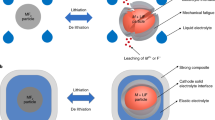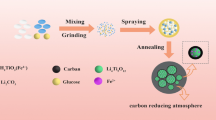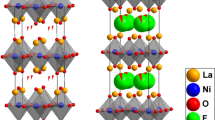Abstract
To achieve the desirable dual characteristics of high-capacity performance and low-cost production for the batteries of tomorrow, leveraging of multi-redox reactions of Earth-abundant transition metals in electrodes is fundamentally important. Here we identify an amorphous iron fluorosulfate electrode, a-LiFeSO4F, that can exploit both the intercalation and conversion reactions with a stable reversibility. The a-LiFeSO4F electrode delivers a capacity of 360 mAh g−1 with ~98.6% capacity retention after 200 cycles even at an elevated temperature (60 °C). In contrast to the conventional intercalation/conversion-type electrodes, the reversible cycle stability is attributed to the inherent amorphous structure of a-LiFeSO4F, whose structural integrity is not severely disturbed even after the conversion reaction, allowing its continuation as an intercalation host. We believe that this cycle stability of the intercalation/conversion reaction can be generally extended to various amorphous intercalation materials, offering new insights into the design of high-capacity electrodes through the exploitation of multi-mechanistic lithiation processes.
This is a preview of subscription content, access via your institution
Access options
Access Nature and 54 other Nature Portfolio journals
Get Nature+, our best-value online-access subscription
$29.99 / 30 days
cancel any time
Subscribe to this journal
Receive 12 digital issues and online access to articles
$119.00 per year
only $9.92 per issue
Buy this article
- Purchase on Springer Link
- Instant access to full article PDF
Prices may be subject to local taxes which are calculated during checkout




Similar content being viewed by others
Data availability
All data generated and analysed in this study are available within the article and its Supplementary Information.
References
Aricò, A. S., Bruce, P., Scrosati, B., Tarascon, J.-M. & van Schalkwijk, W. Nanostructured materials for advanced energy conversion and storage devices. Nat. Mater. 4, 366–377 (2005).
Chu, S., Cui, Y. & Liu, N. The path towards sustainable energy. Nat. Mater. 16, 16–22 (2017).
Tarascon, J. M. & Armand, M. Issues and challenges facing rechargeable lithium batteries. Nature 414, 359–367 (2001).
Padhi, A. K., Nanjundaswamy, K. S. & Goodenough, J. B. Phospho‐olivines as positive‐electrode materials for rechargeable lithium batteries. J. Electrochem. Soc. 144, 1188 (1997).
Barpanda, P. et al. A 3.90 V iron-based fluorosulphate material for lithium-ion batteries crystallizing in the triplite structure. Nat. Mater. 10, 772–779 (2011).
Recham, N. et al. A 3.6 V lithium-based fluorosulphate insertion positive electrode for lithium-ion batteries. Nat. Mater. 9, 68–74 (2010).
Nishimura, S.-i, Nakamura, M., Natsui, R. & Yamada, A. New lithium iron pyrophosphate as 3.5 V class cathode material for lithium ion battery. JACS 132, 13596–13597 (2010).
Padhi, A., Nanjundaswamy, K., Masquelier, C., Okada, S. & Goodenough, J. Effect of structure on the Fe3+/Fe2+ redox couple in iron phosphates. J. Electrochem. Soc. 144, 1609–1613 (1997).
Melot, B. C. & Tarascon, J.-M. Design and preparation of materials for advanced electrochemical storage. Acc. Chem. Res. 46, 1226–1238 (2013).
Wu, F. & Yushin, G. Conversion cathodes for rechargeable lithium and lithium-ion batteries. Energy Environ. Sci. 10, 435–459 (2017).
Cabana, J., Monconduit, L., Larcher, D. & Palacin, M. R. Beyond intercalation‐based Li‐ion batteries: the state of the art and challenges of electrode materials reacting through conversion reactions. Adv. Mater. 22, E170–E192 (2010).
Yu, S.-H., Feng, X., Zhang, N., Seok, J. & Abruña, H. D. Understanding conversion-type electrodes for lithium rechargeable batteries. Acc. Chem. Res. 51, 273–281 (2018).
Nitta, N., Wu, F., Lee, J. T. & Yushin, G. Li-ion battery materials: present and future. Mater. Today 18, 252–264 (2015).
Manthiram, A. A reflection on lithium-ion battery cathode chemistry. Nat. Commun. 11, 1550 (2020).
Shimoda, K., Shikano, M., Murakami, M. & Sakaebe, H. Capacity fading mechanism of conversion-type FeF3 electrode: investigation by electrochemical operando nuclear magnetic resonance spectroscopy. J. Power Sources 477, 228772 (2020).
Li, L. et al. Origins of large voltage hysteresis in high-energy-density metal fluoride lithium-ion battery conversion electrodes. JACS 138, 2838–2848 (2016).
Pender, J. P. et al. Electrode degradation in lithium-ion batteries. ACS Nano 14, 1243–1295 (2020).
Yu, S. H., Lee, S. H., Lee, D. J., Sung, Y. E. & Hyeon, T. Conversion reaction‐based oxide nanomaterials for lithium ion battery anodes. Small 12, 2146–2172 (2016).
Yu, L. et al. Investigation on the overlithiation mechanism of LiCoO2 cathode for lithium ion batteries. J. Electrochem. Soc. 168, 050516 (2021).
Weker, J. N., Wise, A. M., Lim, K., Shyam, B. & Toney, M. F. Operando spectroscopic microscopy of LiCoO2 cathodes outside standard operating potentials. Electrochim. Acta 247, 977–982 (2017).
Usubelli, C. et al. Understanding the overlithiation properties of LiNi0.6Mn0.2Co0.2O2 using electrochemistry and depth-resolved X-ray absorption spectroscopy. J. Electrochem. Soc. 167, 080514 (2020).
Li, H., Balaya, P. & Maier, J. Li-storage via heterogeneous reaction in selected binary metal fluorides and oxides. J. Electrochem. Soc. 151, A1878 (2004).
Badway, F., Cosandey, F., Pereira, N. & Amatucci, G. G. Carbon metal fluoride nanocomposites: high-capacity reversible metal fluoride conversion materials as rechargeable positive electrodes for Li batteries. J. Electrochem. Soc. 150, A1318 (2003).
Pereira, N., Badway, F., Wartelsky, M., Gunn, S. & Amatucci, G. G. Iron oxyfluorides as high capacity cathode materials for lithium batteries. J. Electrochem. Soc. 156, A407 (2009).
Wu, F. et al. 3D honeycomb architecture enables a high-rate and long-life Iron (III) fluoride-lithium battery. Adv. Mater. 31, e1905146 (2019).
Hua, X. et al. Revisiting metal fluorides as lithium-ion battery cathodes. Nat. Mater. 20, 841 (2021).
Ju, L. et al. Significantly improved cyclability of conversion‐type transition metal oxyfluoride cathodes by homologous passivation layer reconstruction. Adv. Energy Mater. 10, 1903333 (2020).
Jung, S.-K. et al. New iron-based intercalation host for lithium-ion batteries. Chem. Mater. 30, 1956–1964 (2018).
Nakai, S. et al. Core-exciton absorption in the F K absorption spectra of 3d transition-metal fluorides. Phys. Rev. B 37, 10895 (1988).
Vinogradov, A. et al. Low-lying unoccupied electronic states in 3d transition-metal fluorides probed by NEXAFS at the F 1s threshold. Phys. Rev. B 71, 045127 (2005).
Jung, S.-K. et al. Lithium-free transition metal monoxides for positive electrodes in lithium-ion batteries. Nat. Energy 2, 16208 (2017).
Kitajou, A., Momida, H., Yamashita, T., Oguchi, T. & Okada, S. Amorphous xNaF–FeSO4 systems (1 ≤ x ≤ 2) with excellent cathode properties for sodium-ion batteries. ACS Appl. Energy Mater. 2, 5968–5974 (2019).
Wang, F. et al. Ternary metal fluorides as high-energy cathodes with low cycling hysteresis. Nat. Commun. 6, 6668 (2015).
Grochala, W. et al. Crystal and electronic structure, lattice dynamics and thermal properties of Ag(I)(SO3)R (R = F, CF3) Lewis acids in the solid state. Dalton Trans. 41, 2034–2047 (2012).
Badway, F., Cosandey, F., Pereira, N. & Amatucci, G. Carbon metal fluoride nanocomposites: high-capacity reversible metal fluoride conversion materials as rechargeable positive electrodes for Li batteries. J. Electrochem. Soc. 150, A1318 (2003).
Hua, X. et al. Comprehensive study of the CuF2 conversion reaction mechanism in a lithium ion battery. J. Phys. Chem. C. 118, 15169–15184 (2014).
Huang, Q. et al. Cycle stability of conversion-type iron fluoride lithium battery cathode at elevated temperatures in polymer electrolyte composites. Nat. Mater. 18, 1343–1349 (2019).
Huang, Q. et al. Insights into the effects of electrolyte composition on the performance and stability of FeF2 conversion‐type cathodes. Adv. Energy Mater. 9, 1803323 (2019).
Lin, C.-F. et al. Highly reversible conversion-type FeOF composite electrode with extended lithium insertion by atomic layer deposition LiPON protection. Chem. Mater. 29, 8780–8791 (2017).
Xiao, A. W. et al. Understanding the conversion mechanism and performance of monodisperse FeF2 nanocrystal cathodes. Nat. Mater. 19, 644–654 (2020).
Wiaderek, K. M. et al. Comprehensive insights into the structural and chemical changes in mixed-anion FeOF electrodes by using operando PDF and NMR spectroscopy. JACS 135, 4070–4078 (2013).
Ma, F.-F. et al. Structure of triplite LiFeSO4F powder synthesized through an ambient two-step solid-state route. Powder Diffr. 33, 38–43 (2018).
Ati, M. et al. Synthesis and electrochemical properties of pure LiFeSO4F in the triplite structure. Electrochem. Commun. 13, 1280–1283 (2011).
Kresse, G. & Furthmüller, J. Efficient iterative schemes for ab initio total-energy calculations using a plane-wave basis set. Phys. Rev. B 54, 11169 (1996).
Kresse, G. & Joubert, D. From ultrasoft pseudopotentials to the projector augmented-wave method. Phys. Rev. B 59, 1758–1775 (1999).
Monkhorst, H. J. & Pack, J. D. Special points for Brillouin-zone integrations. Phys. Rev. B 13, 5188–5192 (1976).
Hoover, W. G. Canonical dynamics: equilibrium phase-space distributions. Phys. Rev. A 31, 1695–1697 (1985).
Nosé, S. A unified formulation of the constant temperature molecular dynamics methods. J. Chem. Phys. 81, 511–519 (1984).
Acknowledgements
This work was mainly supported by the Samsung Research Funding Centre of Samsung Electronics under project number SRFC-TA1403-53. D.E. acknowledges supports from the Basic Science Research Program through the National Research Foundation of Korea (NRF) funded by the Ministry of Education (2021R1A6A3A13039400).
Author information
Authors and Affiliations
Contributions
J.H., S.-K.J., I.H. and K.K. conceived and designed the experiments. J.H. prepared samples and carried out the main experiments. S.-P.C. conducted TEM analysis. J.H., D.E., H.P. and T.H. discussed the SXAS results. D.E., T.H. and K.-H.K. assisted with sample preparation. J.-H.S., S.Y. and K.O. carried out density functional theory calculation. J.H. and K.-H.K. discussed the XRD results. J.H., S.-K.J. and K.K. wrote the paper. D.E., S.-K.J., G.K. and K.K. revised or commented on the manuscript.
Corresponding author
Ethics declarations
Competing interests
The authors declare no competing interests.
Peer review
Peer review information
Nature Energy thanks the anonymous reviewers for their contribution to the peer review of this work.
Additional information
Publisher’s note Springer Nature remains neutral with regard to jurisdictional claims in published maps and institutional affiliations.
Supplementary information
Supplementary Information
Supplementary Notes 1–3, Tables 1–2 and Figures 1–16.
Rights and permissions
Springer Nature or its licensor (e.g. a society or other partner) holds exclusive rights to this article under a publishing agreement with the author(s) or other rightsholder(s); author self-archiving of the accepted manuscript version of this article is solely governed by the terms of such publishing agreement and applicable law.
About this article
Cite this article
Heo, J., Jung, SK., Hwang, I. et al. Amorphous iron fluorosulfate as a high-capacity cathode utilizing combined intercalation and conversion reactions with unexpectedly high reversibility. Nat Energy 8, 30–39 (2023). https://doi.org/10.1038/s41560-022-01148-w
Received:
Accepted:
Published:
Issue Date:
DOI: https://doi.org/10.1038/s41560-022-01148-w
This article is cited by
-
Combining intercalation and conversion reversibly
Nature Energy (2022)



